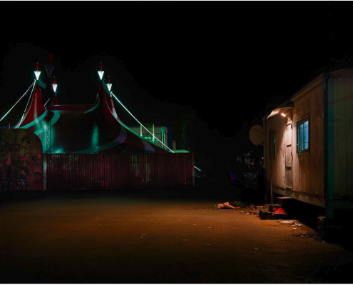
Underbelly is a photographic installation that follows the trail of an imagined serial killer in the city of Beirut. It is loosely based on Roberto Bolaño’s detective novel 2666, which chronicles the murder of one hundred and twelve women in Santa Teresa and the fruitless police investigation that stems from it. As the bodies pile up, a vision of a city riddled by an underlying evil emerges. Lara Tabet ventures into the city’s outskirts, offering a portrait of Beirut at night through a fictional narrative of unsolved murders.
The corpses of the dead women are scattered around town. In the margins, the streetlights are scarce and the city guards well its dead.
The tableau photographs are taken with a large format camera. They portray crime scenes in which women’s lifeless bodies lie almost imperceptible in the theatricality of nocturnal urban space.
The tableaux are juxtaposed with microscopic photos depicting bodily fluids used in criminalistics and snapshots of fake evidence from the crime scenes, the aesthetic of which is reminiscent of forensic photography. These visuals highlight the differential meaning an object produces when transformed into a photographic subject, and reference the history of photography and its long-standing relationship to crime. From the widespread usage of forensic images as an evidence-gathering tool to the inevitable transformation of the crime scene into the site of contemporary narrative speculation and fiction, or from its documentation to its staging, murder questions notions of truth and perception.
While trespassing to take these photos, Tabet was often stopped and questioned by the police and local security. The artist uses photography as a performative and transgressive gesture, one that recurs throughout her practice, through her exploration of liminal spaces, or zones at the edge of the public and the private. By choosing to photograph “dead” women she directs a female gaze upon representations of violent acts of hypersexualization against women’s bodies, thus subverting gender roles.